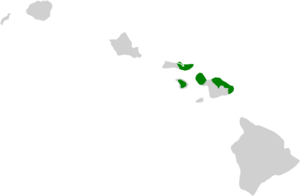Olomaʻo facts for kids
Quick facts for kids Olomaʻo |
|
|---|---|
 |
|
| Conservation status | |
| Scientific classification | |
| Genus: |
Myadestes
|
| Species: |
lanaiensis
|
 |
|
The olomaʻo (Myadestes lanaiensis) is a small, dark bird that used to live only on the Hawaiian islands of Maui, Lānaʻi, and Molokaʻi. It's a type of bird called a solitaire. Sadly, this bird is now listed as Critically Endangered, which means it's very close to disappearing forever.
Another bird, the extinct ʻāmaui, was either a type of 'oloma'o or a different species. It lived only on Oʻahu.
Contents
What Does the Olomaʻo Look Like?
The olomaʻo grows to about 7 inches long, which is roughly the length of a pencil. Both male and female birds look very similar. They have dark brown feathers on their backs and gray feathers on their bellies. Their legs are blackish.

The Olomaʻo's Unique Song
The song of the olomaʻo is quite special. It's a complex and beautiful melody. You might hear flute-like notes, soft, flowing sounds, and even gurgling whistles.
Its regular call sounds a bit like a cat's rasp. It can also make a high-pitched note, similar to a police whistle.
Where Did They Live and What Did They Eat?
Olomaʻo birds lived in areas with thick plants, especially in deep valleys called gulches. They often stayed close to the ground, perching without moving much.
Like other native Hawaiian thrushes, they would quiver their wings. These birds mainly ate fruit and insects.
Why Is the Olomaʻo Critically Endangered?
The olomaʻo is still listed as Critically Endangered. This means scientists believe a very small number might still exist, even though they are rarely seen. The last definite sighting on Oʻahu was in the 1850s. On Lānaʻi, it was last seen in 1933. On Molokaʻi, the last confirmed sighting was in 1980.
In the late 1800s, the olomaʻo was common on Maui, Lānaʻi, and Molokaʻi. However, many things caused their numbers to drop drastically.
- Loss of Habitat: People cleared a lot of land for building, including the town of Lānaʻi City. This destroyed the places where the birds lived.
- New Diseases: Introduced mosquitoes brought a disease called avian malaria to the islands. Hawaiian birds had no protection against this disease, and many died.
- Introduced Animals: Animals brought to the islands, like feral pigs, also caused problems. Pigs would create muddy pools when they wallowed. These pools became perfect places for mosquitoes to breed, spreading more disease.
Understanding the Olomaʻo's Family
The olomaʻo is related to other Hawaiian thrushes. These include the puaiohi (M. palmeri), the ʻōmaʻo (M. obscurus), and the probably extinct kāmaʻo (M. myadestinus).
Scientists recognize three types, or subspecies, of the olomaʻo:
- M. l. woahensis - the ʻāmaui
- M. l. lanaiensis - the Lānaʻi thrush
- M. l. rutha - the Molokaʻi thrush


